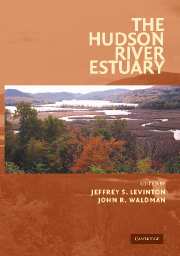Book contents
- Frontmatter
- Contents
- Preface
- List of Contributors
- The Hudson River Estuary
- 1 The Hudson River Estuary: Executive Summary
- GEOLOGICAL, PHYSICAL, AND CHEMICAL SETTING OF THE HUDSON
- PRIMARY PRODUCTION, MICROBIAL DYNAMICS, AND NUTRIENT DYNAMICS OF THE HUDSON
- HUDSON RIVER COMMUNITIES, FOOD WEBS, AND FISHERIES
- CONTAMINANTS AND MANAGEMENT ISSUES OF THE HUDSON RIVER ESTUARY
- Index
- Plate section
1 - The Hudson River Estuary: Executive Summary
Published online by Cambridge University Press: 06 January 2010
- Frontmatter
- Contents
- Preface
- List of Contributors
- The Hudson River Estuary
- 1 The Hudson River Estuary: Executive Summary
- GEOLOGICAL, PHYSICAL, AND CHEMICAL SETTING OF THE HUDSON
- PRIMARY PRODUCTION, MICROBIAL DYNAMICS, AND NUTRIENT DYNAMICS OF THE HUDSON
- HUDSON RIVER COMMUNITIES, FOOD WEBS, AND FISHERIES
- CONTAMINANTS AND MANAGEMENT ISSUES OF THE HUDSON RIVER ESTUARY
- Index
- Plate section
Summary
From the Tear of the Clouds to the Verrazano
The ecological and cultural importance of the Hudson is surely not revealed by its size. Its drainage basin is about 34,000 square kilometers (km) (13,000 square miles), which is less than one percent of the United States. In contrast, the Mississippi drains about half of the area of the lower 48 states. Compared to the mighty Mississippi's length of 3,700 km, the Hudson, originating in the Adirondacks and pulsing to the sea through the Verrazano Narrows, flows over a main course of only 500 km (ca. 300 miles).
Henry Hudson and his crew first saw the mouth of the Hudson in 1609, but it wasn't until the 1870s that its origin was declared, at tiny Lake Tear of the Clouds, near Mt. Marcy in the Adirondacks. The small rivers and streams flowing from Adirondack peaks over 1000 meters (m) in elevation descend to a lowland drainage usually less than 100 m above sea level. Below Troy the river is navigable to the Narrows entrance to the ocean.
The Terrane
The Hudson River drains New York, and parts of Vermont, Massachusetts, Connecticut, and New Jersey. The basin contains three subareas: the upper Hudson from Mt. Marcy to Troy, the Mohawk from Rome to Troy, and the lower Hudson from Troy to New York Bay (we try to stick to this terminology throughout the book, but some authors have failed us).
- Type
- Chapter
- Information
- The Hudson River Estuary , pp. 1 - 10Publisher: Cambridge University PressPrint publication year: 2006
- 1
- Cited by



